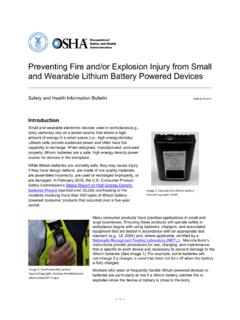Transcription of Standard candles - University of Exeter
1 Dr Jennifer Hatchell1 StandardcandlesContents:What is a ' Standard Candle'?Measuring distance using Standard candlesTypes of Standard candle:1. Cepheid variables2. Type 1A supernovaeMeasuring distance using Standard candles In astronomy, a Standard candle is a source that has a known = total power output, measured in watts (W) or solar luminosities (L ).1 L = x 1026 WWhat is a ' Standard candle'?For distances which are too large to measure using parallax, astronomers use ' Standard candles '.Light sources which are further away appear fainter because the light is spread out over a greater area. If we know how luminous a source really is, then we can estimate its distance from how bright it appears from light which reaches Earth has spread out over a area of sphere = 4 r2 received power = source luminosity per unit area area of sphereF = L 4 r2 The larger the distance, the smaller the power that we traditionally measure the received power per unit area in magnitudes, but watts per square metre (W/m2) is also of luminosity LEarthOn Earth, the received power per unit area is then radius of sphere = distance to earth, rDr Jennifer Hatchell2 Types of Standard candle1.
2 Cepheid variablesCepheid variables are a special type of star with a luminosity which varies on a regular cycle. Around 1908, Henrietta Leavitt discovered that the period of the variability was closely linked to the luminosity of the , if you time the variability of a Cepheid then you can predict its luminosity. And if you know its luminosity and how bright it appears from Earth, then you can calculate the distance. Cepheids are used to measure the distance of galaxies out to about 30,000,000 parsecs (30 Mpc). Cepheids are what Edwin Hubble used to determine the distances of nebulae (ie. galaxies) and derive the Hubble are several types of ' Standard candle' objects for which we can predict the luminosity from some other measurement.
3 Two of the most important are Cepheid variable stars and type 1A supernovae. 2. Type 1A supernovaeSupernovae occur when massive stars explode at the end of their lives. A white dwarf star in a binary pair with a red dwarf star steals mass from the red dwarf until it is too massive to support itself against gravity any more. Then its core collapses, starting a runaway nuclear reaction and a bright explosion. Because the collapse always happens at the same mass, the luminosity of the explosion is always the same. From this known luminosity we can estimate the are very bright often as bright as all the stars in a whole galaxy put together. Because they are so bright, we can see them at very great distances, up to around 10,000,000,000 disadvantage of supernovae as Standard candles is that they don't hang around - you have to spot them when they go off, or shortly afterwards.






